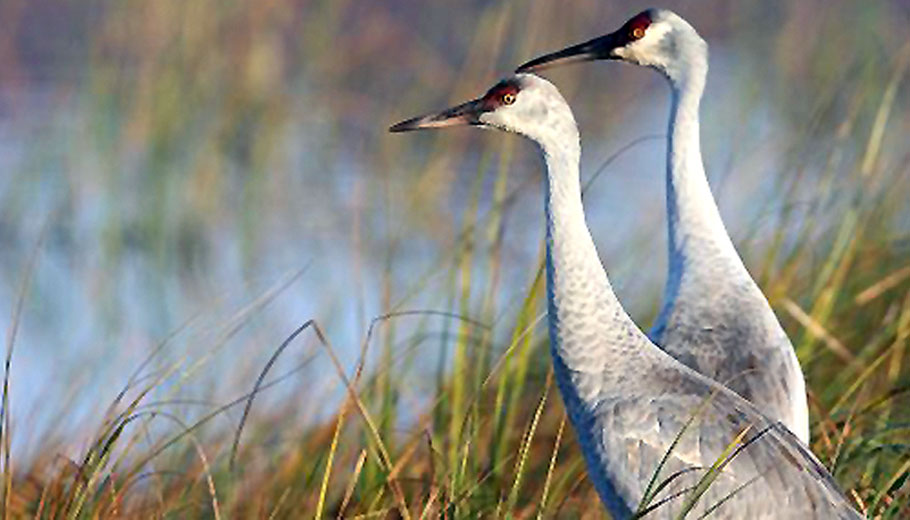
Annual event set for April 15
By Greg Seubert
The International Crane Foundation is looking for a few bird watchers.
The Baraboo-based foundation will hold its annual Midwest Crane Count from 5:30 a.m. to 7:30 a.m. Saturday, April 15, at several locations in Wisconsin, Illinois, Indiana, Iowa, Michigan, Minnesota and Ohio.
Dean Johnson has coordinated Waupaca County’s count for several years and has a few counters lined up for this year’s event.
“I guess the biggest importance of the crane count is we help monitor the abundance of them and their distribution,” he said. “I’m looking at about 14 (counters) right now, which would be the highest I’ve had in awhile. I’m getting a bunch of family involved. People have gotten older and gotten out of it, so I’m trying to get a younger crowd. I’d like to get the Boy Scouts interested.”
Counters sign up at savingcranes.org/count, where they can access all the information they need, including locations of about 300 sites; how to identify sandhill and whooping cranes; and how to submit their data sheet once the count is completed.
Most of Waupaca County’s sites are south of a line that runs from Scandinavia to Ogdensburg to Manawa.
“I think (counters) generally stick around where they live,” Johnson said. “I leave it to them right now because I don’t have that many. I would like to get up to 21 because there are 21 grid squares in the county. Next year, I’m going to try to key it down to the best spots.”
How counters work
Counters record the number of cranes they see and hear and submit their information online to the International Crane Foundation.
“The biggest thing is the unison call because it’s really the only way to identify breeding pairs,” Johnson said. “You don’t necessarily have to see the birds, but if you hear that call, you can mark that as a breeding pair. Any sandhills you see flying or eating in your area, you record those and also any other wildlife. Even if there’s no presence of sandhills, that’s also important.”
The International Crane Foundation’s mission is to conserve cranes and the ecosystems, watersheds and flyways on which they depend.
“We provide knowledge, leadership and inspiration to engage people in resolving threats to cranes and their diverse landscapes,” said Jodi Legge, the organization’s director of external affairs. “The ICF reach extends across the globe, with offices and staff in China, Uganda, Kenya, Zambia and South Africa, as well as Texas. It works through strong partnerships with local organizations, governments, universities, businesses and others in these regions.”
Wisconsin is home to two species of cranes: sandhill and whooping. Both species winter in the southern United States and sandhills returned to Waupaca County in early March.
Unregulated hunting and loss of habitat nearly pushed the whooping crane to the brink of extinction. Only 21 wild and two captive birds remained by 1941, but conservation efforts have led to their limited recovery. The population now exceeds 800 birds.
“I have never spotted one, but I think there were five whooping cranes spotted in the county during last year’s count,” Johnson said.
Sandhill cranes, on the other hand, are thriving in Waupaca County, especially in the southern half of the county. They can often be seen along U.S. Highway 10 near Waupaca and in rural farm fields.
Besides Waupaca County, the count is also held in several adjacent counties.
Signing up to count
The following county coordinators can be contacted to sign up for this year’s count:
• Waupaca County: Johnson, ([email protected]).
• Outagamie County: Adam Brandt, ([email protected], 920-779-6433).
• Waushara County: Tamara Curtis ([email protected], 920-858-3245).
• Winnebago County: Evelyn Meuret ([email protected], 920-573-7828).
• Shawano County: Tim and Colin Ewing, ([email protected], 715-758-6999).
“The counters gather all the data,” Johnson said. “It used to be the coordinator’s job to gather all the data and submit it, but now with computers and modern technology, it’s all done online. It all goes to the International Crane Foundation. I don’t even see the results, but I do like to hear from the counters with what they saw out there.
“It’s really pretty simple,” he added. “Anybody can get out and do it. It’s a great thing to do with kids and grandchildren: get them out and show them the importance of being out there with nature. That’s how I got started. I read it in the paper and took a niece. Nature gives so much to us. It’s nice to be able to give back.”
